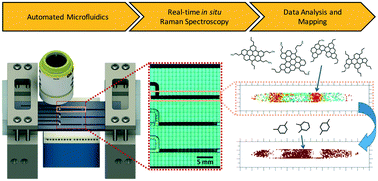An automated microfluidic system for the investigation of asphaltene deposition and dissolution in porous media†
Abstract
Asphaltenes, among the most complex components of crude oil, vary in their molecular structure, composition, and self-assembly in porous media. This complexity makes them challenging in laboratory characterization methods. In the present work, a novel microfluidic device was designed to access in situ transient, high-fidelity information on asphaltene deposition and dissolution within porous media. The automated microfluidic device features three independent 4.5 μL packed-bed microreactors on the same chip. The deposition of asphaltenes was investigated at five different temperatures (ranging from 25–65 °C) in addition to dissociation with xylenes. Our findings demonstrate a decrease in the dispersity of asphaltene nanoaggregates in the porous media when the deposition temperature is increased. Furthermore, the direct quantification of the dissociation solvent was made possible by in situ Raman spectroscopy. The average occupancy of xylenes and xylene-free porous media (or unrecognized sites) was estimated to be 0.41 and 0.66, respectively. It was observed that asphaltenes deposited at higher deposition temperatures are more difficult to dissociate by xylenes than those deposited at lower temperatures. In order to develop efficient remediation treatments in energy production operations, the convoluted behaviours of asphaltenes in porous media must be understood on a molecular level. Automated microfluidic systems have the potential to streamline treatment designs, improve their efficiency, and enable the design of green chemistry in conventional energy production operations.



 Please wait while we load your content...
Please wait while we load your content...